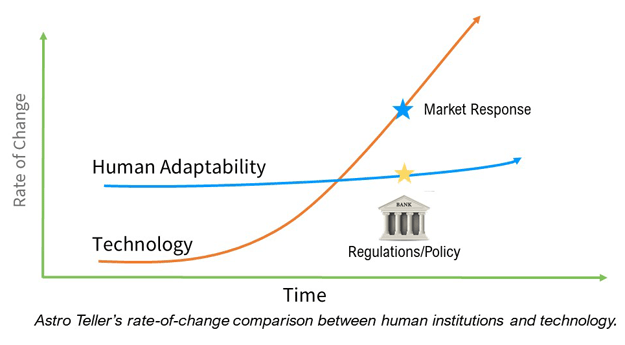
When we wrote our article, Why 2023 "Will Be the Year of the Portfolio," we weren’t thinking that there would need to be a sequel written any time soon. But thanks to all the other surprises from the Silicon Valley Bank failure – a case study of a 2023 portfolio disaster – it made sense to continue the discussion.
The fundamental question is: “What should we learn from this calamity?” We started our knowledge quest by conducting two searches.
First, we asked ChatGPT, “What are three things we should learn from the Silicon Valley Bank failure?” In its typical calm, collected and confident fashion it replied:
"I'm sorry, but I have no record of Silicon Valley Bank ever experiencing a significant failure. In fact, Silicon Valley Bank (SVB) is considered one of the most successful banks in the United States, with a focus on providing banking services to technology and innovation-focused companies. SVB has a reputation for being innovative and agile, and for developing strong relationships with its clients."
OK, ChatGPT is still only trained on data through 2021, but “Gee how time flies.” Note the phrases in bold as they will be important to the learnings from this event.
Next, we went back to good old Google with the same question. At this point, we discovered that the search for “lessons learned from SVB” was not a novel idea. The search returned over a dozen articles with either three or five lessons learned in the title – all written within a week of the failure. We had already documented our ideas about what equipment finance companies should learn from this event, but we wanted to see what others thought about the topic in general and different industries.
The learnings enumerated were similar. Some of them were consistent with our thinking and gave us some supporting insight. Others, one in particular, were off target, in our view, but ironically still supported one of our key learnings. [A brief summary of that research with comments is available in the Resources section at the end of this article for those specifically interested in banking.]
Thinking in terms of portfolio managers and equipment finance business leaders in general, there are three key learnings we’ve identified from the SVB collapse.
1. Never put all your chickens in one basket.
“All your eggs in one basket” the obvious, and fundamental, portfolio management edict. All of the SVB learning lists had this one. This is always important to an equipment finance portfolio manager. It’s clear now, and should have been to the SVB management, that the securities backing their deposits were out of balance. The imbalance was in both concentration and interest rate risk, the massive investment in “safe” treasury bond par values eroded due to record inflation and interest rate increases undermining the bank’s liquidity. The equivalent in equipment finance portfolios would be contracts with spreads that decrease with higher rates or payments that increase. Both erode the profit of the portfolio. But spread and security erosion is not fatal in and of itself as long as the borrower’s business remains an ongoing concern.
The subtlety here was about customers, not assets. To extend the metaphor, SVB had all the same chickens in the same basket. SVB served, almost exclusively, tech companies and tech investors – both the suppliers and users of venture capital. Those customers create a multiplier of the asset risk because they used the same sophisticated technology that SVB had as the core of its strategy to move as one and move their money with a speed and scale never before seen in banking. ChatGPT, with out-of-date information, called out SVB’s relationships with a large concentration of well-funded technology front runners as a competitive advantage. But those relationships did nothing to counter the uniformity and synchronization of behavior with which those customers moved and, in turn, made their security challenge unrecoverable.
Equipment finance portfolio managers must pay attention to concentrations in three factors: assets, industries, and customers. They must monitor both internal performance data for these factors as well as external trend data, e.g., asset values in orderly and forced liquidation scenarios or payment delinquency by NAICS codes. Every asset-based payment stream has an associated risk, don’t let a concentration in markets or customers increase that risk exponentially.
2. Fight fire with fire.
Neither federal regulators nor SVB’s management respected the focus of the SVB strategy – technology-centric depositors. Clearly, they did not use the same data and technology as their customers to prepare for, monitor, or respond to the risks presented by inflation and higher interest rates on deposits controlled by large depositors who could electronically move their funds simultaneously. Specifically, neither SVB nor regulators were effectively using the internet-based software technology that is the bread and butter of their Silicon Valley VC and startup customers.
Software is an exponential technology, it builds on top of that which was built before and grows by multiples, not additions. Every equipment finance company should assume that all of their customers are using modern software and connected by it. Portfolio managers must be focused on gathering, analyzing, and acting on data at the speed of social media. The more concentrated their customer distributions, the more risk associated with both that industry segment and those customers behavior as a paying business. Software can both amplify and mitigate risk. Smart portfolio managers are focused on the latter.
Only technology can defend against technology.
3. Adapt or perish
“The third lesson we can draw from SVB’s collapse is that bank regulation works.”
This one surprised us the first time we read it. Unfortunately, it was a recurring theme from pundits who clearly are not aware of HG Wells’ famous quote on the imperative of adaptation. If bank regulations and regulators had been effective, the SVB event would not have happened. Nor would the FDIC and Federal Reserve have had to abandon their risk management policies to respond to the collapse while under incredible political pressure 72 hours later.

Astro Teller, CEO of Google X Research Center, described this situation best with his curve showing how humans, particularly societies and governments, respond to change linearly while the rate of change in technology accelerates exponentially. Bank regulations, the policies, and the procedures of banking industry portfolio managers do not accommodate the rate at which markets and customers move with digital technology. Traditional banking policy and regulation measures did not anticipate a customer base moving $42 billion dollars in one day. No one violated a rule or regulation in the SVB event, but the bank and regulators were just unprepared for what those rules allowed when the movement of both people and money happens at “viral” speeds.
But a single business can change its policies proactively and rapidly if it is using data to both monitor and predict future behaviors. A single business can prepare for the speed of technology if its leaders make identifying and mitigating risk with digital technology a core strength of the organization. Are lease structure policies still appropriate? Should sales strategies shift from certain assets and markets to broaden the portfolio? Should or can underwriting policies shift to hedge spread compression, e.g., strong A credits, deal security, e.g., residual value monitoring, or customer payment affordability, e.g., EFA versus True Lease deal types? Portfolio policies must be continuously analyzed for risk because the nature of risk changes.
A fundamental of equipment finance portfolio design is that it must contain a diversity of assets, industries, customers, risk, and asset lifecycle. But 2023 is the Year of the Portfolio because those risks are changing at a pace not previously seen by the business leaders in charge today. SVB and the Federal Reserve were not prepared because they do not yet respect the speed and reach of the technology that businesses and society use today. Equipment finance portfolio managers cannot make that same mistake and must adopt the digital tools that enable monitoring and measuring risk as it changes in real time.
Business leaders must be prepared to change the company’s portfolio management, operational, and risk policies at the same speed with which the waves of change in markets now move. Indeed, they must adapt in anticipation of changes so that they can ride these waves, not be crushed by them.
Resources: Quick Overview of “Lessons Learned from SVB” Google Search.
3 Lessons from Silicon Valley Banks Failure
- Single relationship base – tech and VCs
- Tech enabled – ultra fast communications and actions. Not ready for the market they served.
- Bank regs work – saved bank. Not true. Didn’t follow regulations.
3 Lessons from Silicon Valley Banks Failure Insights for Success
- Long term bonds looked safe but became not – didn’t monitor risk levels.
- Single, high-tech clientele – aware and fast moving with tech
- Bank regs work. Not true. Political.
Silicon Valley Bank: Lessons Learned from Failed 'Tech Bank'
- Don’t put all eggs in one basket.
- Use big, safe banks.
- Speed of communication beyond banking policies
Lessons Learned from Silicon Valley Banks Collapse
- $250k too small – bad policy
- Fed Reserve is silly – bad management.
- Hedge funds are vultures.
- Some will buy all of it – relationships still valuable.
- All banks should face same regulations – politics is bad and ineffective
Five Things to Know About the Silicon Valley Bank Collapse
- Major concentration in one industry - tech
- Didn’t adapt to high interest rates and inflation
- Big tech industry weakened rapidly
- Surprisingly abrupt – social media connected customers
- Customers knew FDIC insured small fraction of funds
3 Personal Finance Lessons from the Silicon Valley Bank Failure
- Bad things happen to good companies.
- Diversify
- Watch your FDIC limits
5 Lessons Every Founder Should Have Learned from Silicon Valley Bank
- Use multiple banks to store cash if your balance exceeds $250,000, the limit of the FDIC depositor insurance.
- If your bank lender wants you to sign exclusivity clauses requiring your company to store its money at the bank as a covenant of the loan, negotiate that term.
- A venture capitalist on your board, or among your network, is not a substitute for having an experienced CFO or equivalent expert who understands the innards of financial regulations and can monitor the health of your important financial partners.
- Running operations on revenue from customers is better than using a stockpile of VC cash.
- The likelihood of more bank runs remains a scary possibility because of the speed of sharing agitating messages on social media coupled with the speed of making withdrawals.
